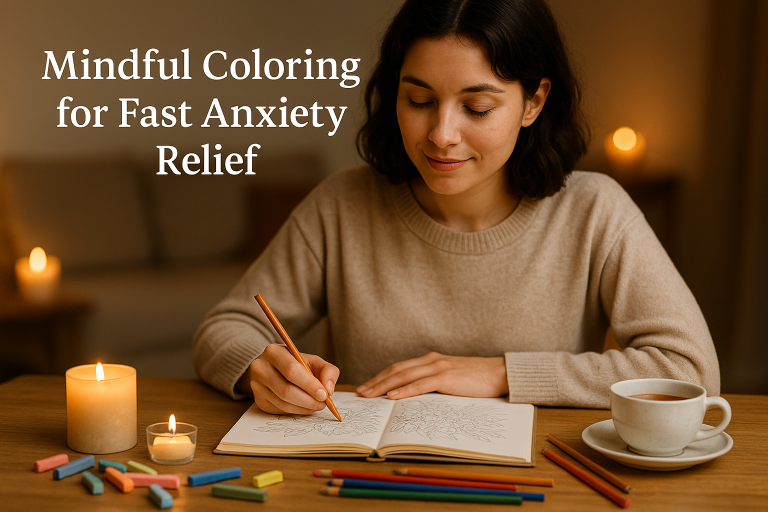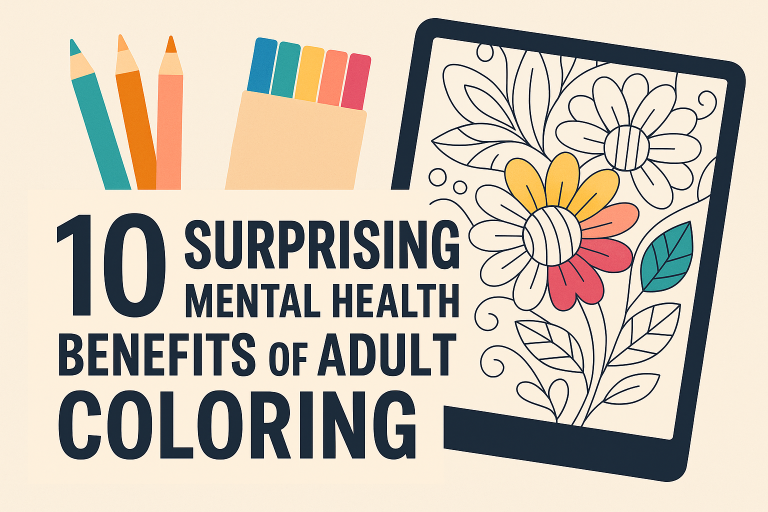7 Life-Changing Benefits of an Adult Coloring Routine (And How to Start Today)
- Introduction to the Power of Adult Coloring
- What Is an Adult Coloring Routine?
- How Coloring Became a Mindfulness Trend
- The Mental and Emotional Benefits of Adult Coloring
- Creative and Cognitive Advantages of a Coloring Routine
- Designing Your Perfect Adult Coloring Routine
- Different Styles of Adult Coloring
- Coloring Techniques to Elevate Your Experience
- Combining Coloring with Other Mindful Practices
- Building a Sustainable Habit
- FAQs About Adult Coloring Routines
- Conclusion and Motivation to Start Today
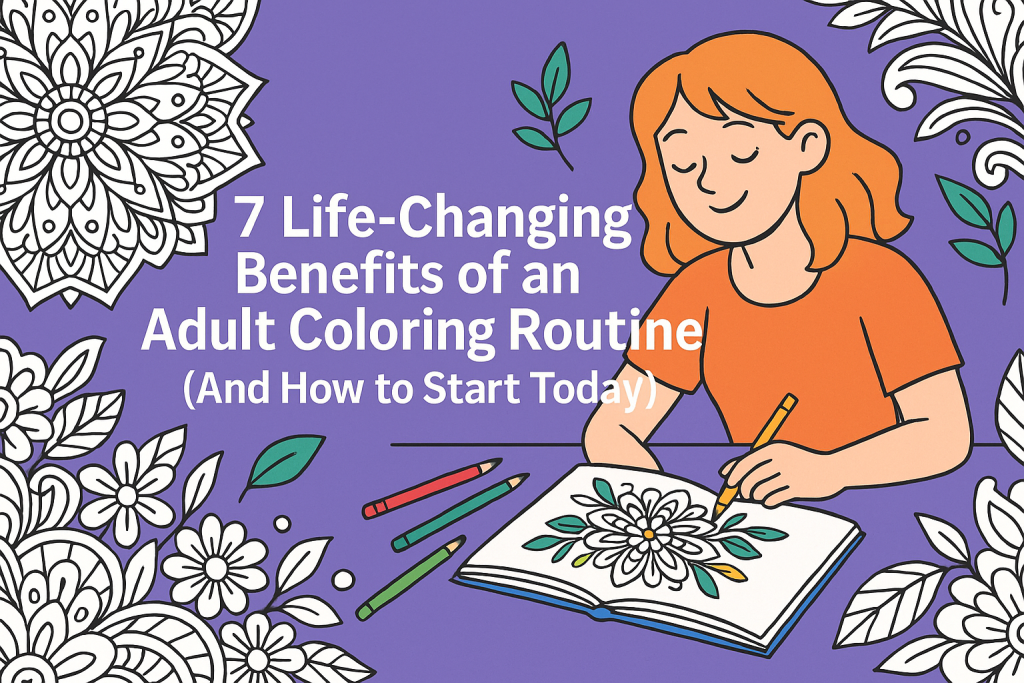
Introduction to the Power of Adult Coloring
Look, I get it. When someone first mentions “adult coloring,” you might picture kindergarteners with crayons or think it’s just another trendy wellness fad. But here’s the straight truth: adult coloring is one of the most accessible, affordable ways to transform your mental health and tap into creativity you didn’t even know you had.
I’ve watched families go from stressed-out, constantly-on-edge households to having dedicated coloring nights where everyone’s actually talking, laughing, and creating together. And the best part? It doesn’t require expensive therapy sessions or complicated meditation apps. Just you, some colored pencils, and a good coloring book.
What is an Adult Coloring Routine?
An adult coloring routine is exactly what it sounds like – setting aside regular time to color intricate designs created specifically for grown-ups. We’re not talking about cartoon characters here. Think detailed mandalas, complex geometric patterns, beautiful nature scenes, or whimsical fantasy artwork that actually challenges your brain.
The “routine” part is key. This isn’t about grabbing a coloring boo once every few months when you’re bored. It’s about creating a consistent practice – maybe 20 minutes before bed, 30 minutes on Sunday mornings, or even just 10 minutes during your lunch break. The magic happens when you make it a regular part of your life, not a one-off activity.
How coloring Became a Mindfulness Trend
Adult coloring exploded around 2013 when publishers started noticing something interesting: grown-ups were buying children’s coloring books. Not for their kids – for themselves. Smart publishers started creating more sophisticated designs, and suddenly everyone stressed-out executives to busy parents discovered what art therapists had known for decades.
The timing wasn’t accidental. Our word got increasingly digital, fast-paced, and overwhelming. People were desperately searching for ways to disconnect from screens and reconnect with something real, something they could control. Coloring offered exactly that – a simple, tactile activity that forces your brain to slow down and focus on one thing at a time.
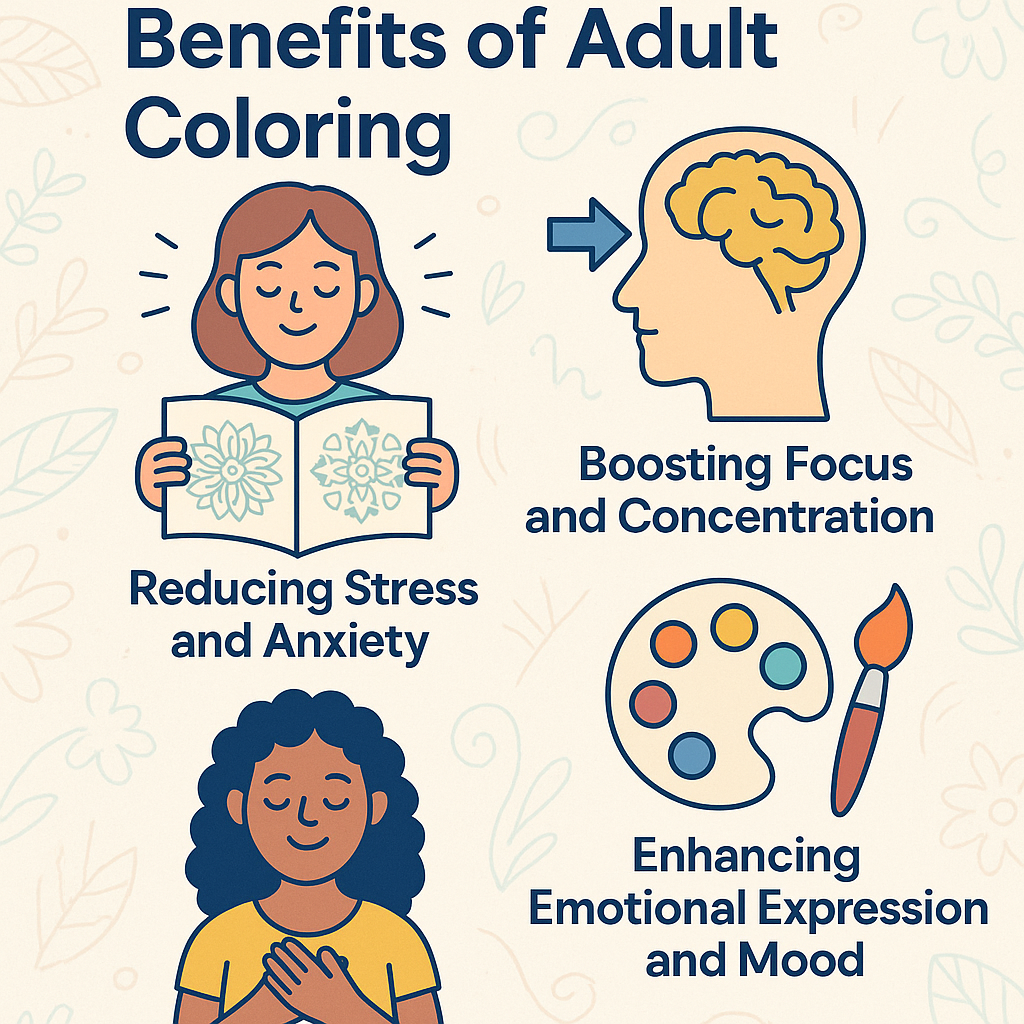
The Mental and Emotional Benefits of Adult Coloring
Reducing Stress and Anxiety
When you’re focused on staying within the lines and choosing the perfect shade of blue, your mind can’t simultaneously worry about tomorrow’s meeting or replay that awkward conversation from last week. It’s like meditation for people who struggle with traditional meditation.
Research shows that coloring activates the relaxation response in your nervous system. Your heart rate slows, your breathing deepens, and stress hormones like cortisol actually decrease. I’ve had customers tell me they finally sleep better after adding coloring to their evening routine. One mom wrote that her “racing thoughts” quieted down for the first time in months.
Boosting Focus and Concentration
In our age of constant notifications and multitasking, the ability to focus on one thing has become a superpower. Coloring trains your brain to concentrate on a single task without getting distracted. You start with 10 minutes of focused coloring, and before you know it, you can apply that same focused attention to work projects, conversations with your kids, or reading a book.
Think of it as strength training for your attention span. Every time you choose a color, plan your approach to a section, or carefully shade an area, you’re building those concentration muscles.
Encouraging Mindfulness and Present-Moment Awareness
Mindfulness sounds complicated, but coloring makes it simple. When you’re deciding whether that flower should be purple or pink, you’re fully present in the moment. You’re not rehashing the past or worrying about the future – you’re right here, right now, making choices about color and design.
This present-moment awareness carries over into the rest of your life. You start noticing things more – the way sunlight hits your kitchen table, how your coffee actually tastes, the sound of your family laughing together. Life gets richer when you learn to pay attention to it.
Enhancing Emotional Expression and Mood
Colors have emotional power, and coloring gives you a safe way to explore and express feelings you might not even have words for. Feeling angry? Maybe you reach for bold reds and oranges. Need calm? You might gravitate toward soft blues and greens.
Many people discover that their mood actually improves after coloring sessions. There’s something deeply satisfying about completing a section or finishing an entire page. You get that little hit of accomplishment and pride – something that’s often missing from our daily routines where tasks never seem truly “done.”
Creative and Cognitive Advantages of a Coloring Routine
Improving Fine Motor Skills and Hand-Eye Coordination
Your hands and brain need to work together when you color. Staying within intricate lines, controlling pressure for different shading effects, and coordinating small movements all contribute to better fine motor skills. This might not seem important until you realize how much of our daily life requires these skills – from typing to cooking to playing with your kids.
For older adults, this coordination practice can help maintain dexterity and hand strength. For anyone who works at a computer all day, it’s a great way to use your hands differently and prevent stiffness.
Stimulating Creativity and Problem-Solving
Every coloring session involves dozens of small creative decisions. Which colors work well together? How can you make this section stand out? Should you use a pattern or solid colors? These might seem like simple choices, but they’re actually exercising your creative problem-solving skills.
Many people find that regular coloring makes them more creative in other areas of life. They start approaching work problems differently, trying new recipes, or even rearranging their living spaces. Creativity builds on itself – the more you practice making creative choices, the more naturally creative thinking comes to you.
Memory and Cognitive Health Benefits
Coloring engages multiple areas of your brain at once. You’re processing visual information, making decisions, planning ahead, and executing fine motor movements. This kind of multi-area brain engagement is exactly what keeps your mind sharp as you age.
Some studies suggest that engaging in creative activities like coloring may help reduce the risk of cognitive decline. While we can’t promise it’ll prevent dementia, we do know that keeping your brain active and challenged is one of the best things you can do for long-term cognitive health.
Designing Your Perfect Adult Coloring Routine
Choosing the Right Time of Day
The best time to color is whenever you can be consistent. That said, different times offer different benefits. Morning coloring can set a calm, focused tone your entire day. Afternoon coloring makes a great stress-relief break, especially if you work from home. Evening coloring helps transition your mind from the day’s chaos to a more relaxed state before bed.
Pay attention to your natural energy patterns. Are you a morning person who needs gentle awakening activities? Try coloring with your coffee. Do you crash at 3PM every day? A 15-minute coloring break might be more effective than another cup of coffee.
Creating a Relaxing Environment
You don’t need a fancy art studio, but a few simple changes can transform your coloring experience. Find a comfortable spot with good lighting – natural light is ideal, but a bright desk lamp works too. Keep your coloring supplies organized and easily accessible. Nothing kills the mood like hunting for a specific colored pencil.
Consider your surroundings. Can you minimize distractions? Maybe put your phone in another room or let family members know this is your quiet time. Some people love complete silence, while others prefer soft background music or nature sounds. Experiment to see what helps you relax the most.
Selecting Coloring Tools and Materials
Here’s where I’ll be straight with you: you don’t need to spend a fortune on premium art supplies. Yes, expensive colored pencils blend beautifully, but regular colored pencils, gel pens, or even crayons can create stunning results. Start with what you have or what fits your budget.
That said, having the right tools can enhance your experience. Colored pencils offer the most control and blending options. Fine-tip markers work great for detailed areas but can bleed through thin paper. Gel pens create vibrant colors but take longer to dry. Try different tools and see what feels good in your hand.
Picking Coloring Books or Pages that Inspire You
This is where I have to share something important: you absolutely do not need to spend $15 – 20 on a coloring book to get high-quality, inspiring designs. I’ve seen people pay premium prices for books they never finish because the designs didn’t actually speak to them.
Look for books with designs that genuinely excite you. Love nature? Find books with intricate botanical illustrations. Drawn to geometric patterns? Seek out mandala collections. Enjoy fantasy themes? Look for books featuring dragons, fairies, or magical creatures.
The key is variety within your interest. A good coloring book should have designs ranging from simpler (for when you want to zone out) to complex (for when you want a real challenge). And here’s a pro tip: always look for books that include bonus pages or different format options. You’re paying for the content, so you should get maximum value.
Setting Realistic Goals and Schedules
Start small and build up. Committing to color for an hour every day sounds ambitious, but if you can’t maintain it, you’ll just feel guilty and quit altogether. Instead, start with 10 – 15 minutes a few times a week. Once that feels natural, you can increase the time or frequency.
Don’t feel pressured to finish entire pages in one sitting. Some intricate designs might take several sessions to complete, and that’s perfectly fine. The goal is the process, not the final product. Some of my customers keep multiple books going at once – a complex one for when they want a challenge, and simpler designs for quick stress relief.
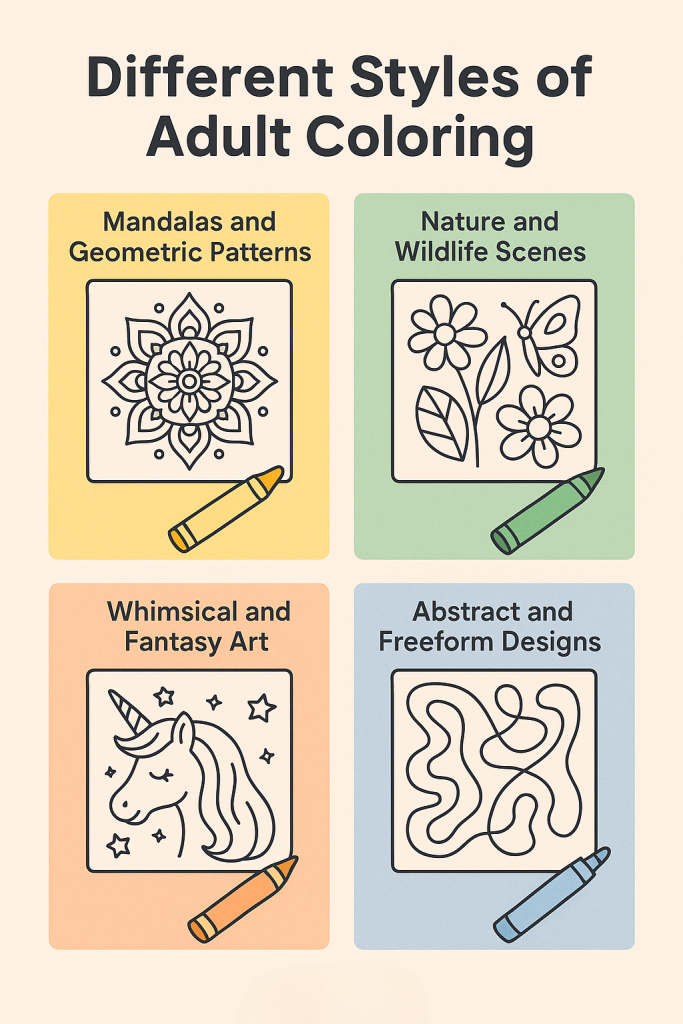
Different Styles of Adult Coloring
Mandalas and Geometric Patterns
Mandalas are circular designs that radiate from a central point, often featuring repeating patterns and intricate details. They’re rooted in spiritual traditions but don’t worry – you don’t need any special knowledge to enjoy coloring them. The repetitive nature of mandala patterns is incredibly soothing and meditative.
Geometric patterns include everything from simple repeated shapes to complex tessellations. These designs appeal to people who love order, symmetry, and mathematical beauty. They’re perfect for when you want something structured and predictable to color.
Nature and Wildlife Scenes
Nature coloring pages might feature detailed flower gardens, forest scenes, ocean life, or individual animals with intricate patterns. These designs let you connect with the natural world even when you’re stuck indoors. Plus, you can be as realistic or as fantastical as you want with your color choices – purple elephants are totally allowed.
Wildlife designs often combine the beauty of animals with decorative elements like patterns within their fur or feathers. These pages can be both calming (think peaceful deer in a meadow) and energizing (imagine a power tiger with ornate stripes).
Whimsical and Fantasy Art
This category includes everything magical: dragons, fairies, unicorns, castles, enchanted forests, and mystical creatures. Fantasy coloring appeals to people who want to escape reality for a while and tap into their imagination. These designs often combine realistic elements with pure fantasy, giving you the best of both worlds.
Whimsical art tends to be playful and charming – think cute animals wearing clothes, magical tea parties, or fairy-tale scenes. These designs can lift your mood and remind you that it’s okay to embrace your playful side, even as an adult.
Abstract and Freeform Designs
Abstract coloring pages feature flowing lines, organic shapes, and patterns that don’t represent anything specific in the real world. These designs give you complete creative freedom – there’s no “right” way to color them. Some people find this liberating, while others prefer more structured designs.
Freeform designs might combine elements from different styles or feature unique artistic interpretations. These pages are great for experimenting with unusual color combinations or trying new techniques without worrying about realism.
Coloring Techniques to Elevate Your Experience
Layering and Shading for Depth
Once you’re comfortable with basic coloring, try layering different colors to create depth and richness. Start with a light base color, then add darker tones in shadow areas and lighter tones where light would naturally hit. This technique works especially well with colored pencils.
Don’t be afraid to build up color gradually. Light layers that you add over time often look more natural and sophisticated than trying to get the perfect shade in one heavy application. Plus, if you make a mistake, it’s easier to blend and correct when you’re working in light layers.
Blending Colors Smoothly
Smooth color transitions can make your finished pages look professional and polished. With colored pencils, you can blend colors directly on the paper by overlapping them while the waxy pigment is still workable. You can also use blending tools like tortillons or even cotton swabs.
For markers, blend while the ink is still wet by overlapping colors or using a lighter marker to pull darker colors into gradient effects. Some markers are specifically designed for blending, but you can achieve good results with regular markers if you work quickly.
Using Color Theory for Impactful Pages
You don’t need an art degree to use basic color theory, but understanding a few principles can dramatically improve your results. Complementary colors (opposites on the color wheel, like blue and orange) create vibrant contrast. Analogous colors (neighbors on the color wheel, like blue, blue-green, and green) create harmony and calm.
Warm colors (reds, oranges, yellows) feel energizing and advance toward the viewer. Cool colors (blues, greens, purples) feel calming and recede. You can use this knowledge to make certain elements of your design pop or to create the overall mood you want.
Combining Coloring with Other Mindful Practices

Coloring with Aromatherapy
Scent has a powerful effect on mood and relaxation. Try lighting a lavender candle for evening coloring sessions, or use peppermint essential oil during morning sessions for gentle alertness. The key is consistency – using the same scent during coloring sessions can create a mental association that helps you relax more quickly over time.
Just be mindful of any scent sensitivities you or your family members might have. And if you’re coloring around children or pets, make sure any essential oils or candles you use are safe for them too.
Pairing with Soft Music or Nature Sounds
The right background audio can enhance your coloring experience without being distracting. Many people enjoy instrumental music – classical, ambient, or even lo-fi beats. Nature sounds like rain, ocean waves, or forest ambiance can be incredibly soothing.
Experiment with different audio options to see what works for you. Some people find that any music is too distracting and prefer complete silence. Others need some background sound to help their minds settle. There’s no wrong choice as long as it supports your relaxation.
Integrating with Journaling or Meditation
Some people like to start their coloring sessions with a few minutes of journaling – writing down the day’s stresses or setting an intention for their coloring time. Others end their sessions by writing about how they feel or what they noticed during the process.
You might also try brief meditation before or after coloring. Even just taking five deep breaths and setting an intention to be present can enhance the mindful aspects of your coloring practice.
Building a Sustainable Habit
Tracking Progress and Celebrating Milestones
Keep track of your coloring sessions in whatever way feels natural – a simple calendar checkmark, a photo journal of completed pages, or even just mental notes. Celebrating small wins helps reinforce the habit. Maybe you reward yourself after coloring for five days straight, or you frame a favorite completed page.
Progress isn’t just about consistency, either. Notice improvements in your technique, times when coloring helped you through a stressful period, or moments when you felt particularly creative or peaceful. These qualitative improvements are just as important as quantitative tracking.
Joining Coloring Communities and Groups
Online communities and local groups can provide inspiration, encouragement, and new ideas. Social media platforms have thriving adult coloring communities where people share their finished pages, discuss techniques, and recommend books. Don’t fee pressure to share your own work unless you want to – just browsing can be inspiring.
Some communities organize challenges like “color a page every day for a month” or theme-based events. These can be fun ways to stay motivated and try new styles or techniques you might not have considered.
Overcoming Common Coloring Roadblocks
The most common obstacle is perfectionism. Remember, there are no coloring police. If you go outside the lines, use “unrealistic” colors, or don’t finish a page, nothing bad happens. The goal is relaxation and enjoyment, not perfection.
Time constraints are another common issue. Remember that even five minutes of coloring can be beneficial. You don’t need hour-long sessions to get stress relief benefits. Keep a small coloring book and pencils handy for unexpected free moments.
Sometimes people get bored or lose interest. This usually means it’s time to try new styles, techniques, or themes. Don’t force yourself to finish books that no longer inspire you. Life’s too short for boring coloring pages.
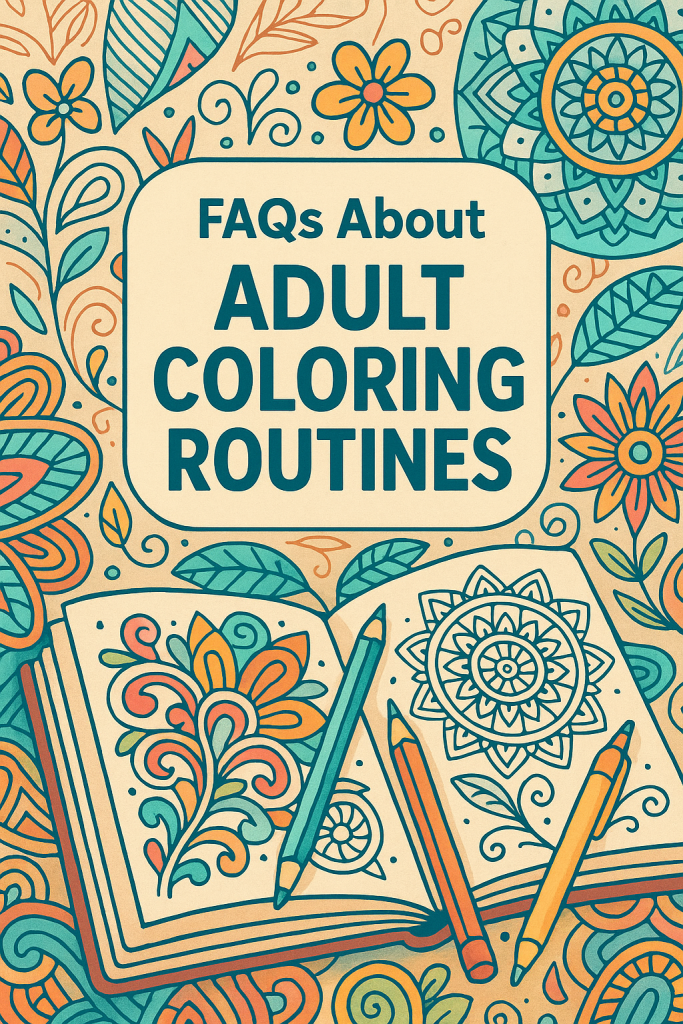
FAQs About Adult Coloring Routines
Q: What if I’m not artistic or creative?
Coloring is about the process, not artistic skill. You’re not creating the designs – someone else already did that hard part. You’re just making color choices and enjoying the meditative process of filling in spaces.
Q: How long should I color each day?
Start with whatever feels manageable – even 10 minutes can be beneficial. Many people find 20 – 30 minutes to be a sweet spot where they can really settle in and relax without feeling like it’s taking over their day.
Q: Are digital coloring apps as good as physical books?
Both have benefits. Physical coloring offers tactile satisfaction and no screen time, which many people find more relaxing. Digital apps offer convenience and unlimited color options. Try both and see what you prefer.
Q: Can children and adults color together?
Absolutely! Family coloring time can be a wonderful bonding experience. Just make sure you have age-appropriate books for everyone. Adult books might be too complex for young children, while children’s books might be too simple for adults to find engaging.
Q: How much should I spend on coloring supplies?
You can start with basic supplies from any store – even dollar store colored pencils will work. As you develop the habit and preferences, you can gradually invest in higher-quality tools if you want to. The most expensive supplies won’t make you happier if you’re not actually using them regularly.
Q: What if I don’t finish pages?
That’s completely normal and fine. Some people prefer to color sections of multiple pages rather than completing entire designs. Others like to finish every page they start. Do whatever feels good to you.

Conclusion and Motivation to Start Today
Look, I could spend another thousand words talking about the benefits of adult coloring, but at some point, you jus need to try it for yourself. The research is clear: regular coloring can reduce stress, improve focus, boost creativity, and provide a much-needed break from our hyper-connected world.
The beauty of starting a coloring routine is how simple it is. You don’t need special training, expensive equipment, or a huge time commitment. You need a coloring book, something to color with, and 10 minutes of your day. That’s it.
I’ve watched families transform their evening routines from everyone staring at separate screens to gathering around the table, sharing colored pencils, and actually talking to each other. I’ve seen stressed adults discover they could quiet their racing minds without medication or complicated meditation practices. I’ve watched people reconnect with creativity they thought they’d lost forever.
Your coloring routine doesn’t need to look like anyone else’s. Maybe you color with your morning coffee. Maybe you color after the kids go to bed. Maybe you color during your lunch break at work. The “perfect” routine is whatever works consistently for your life.
And here’s the thing about affordable, quality coloring books: they remove the barriers that keep people from starting. You don’t need to invest $20 to see if coloring works for you. You don’t need to feel guilty about trying something new. You can start small, build the habit, and expand from there.
So here’s my challenge: give it two weeks. Find a coloring book that actually appeals to you (not just whatever’s cheapest or most convenient), set aside 15 minutes three times a week, and see what happens. Pay attention to how you feel during and after coloring. Notice if your stress levels change, if you sleep better, or if you find yourself more patient with family members.
Two weeks isn’t a huge commitment, but it’s enough time to start experiencing the real benefits. And if it doesn’t work for you? You’ve lost maybe an hour of your life and a few dollars. But if it does work – and I think it will – you’ll have discovered something that can improve your mental health, creativity, and family relationships for years to come.
Your future self is going to thank you for starting today. Trust me on this one.

